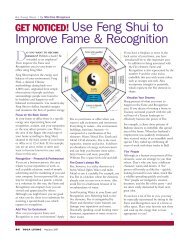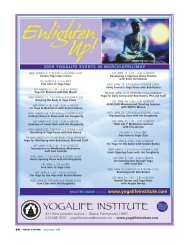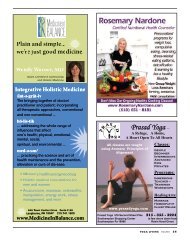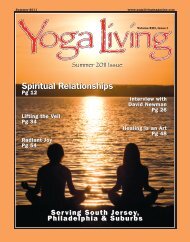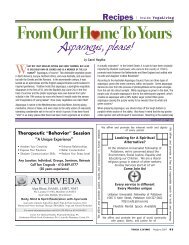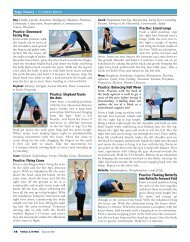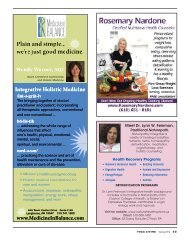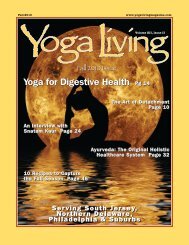Healthy Living - Yoga Living Magazine
Healthy Living - Yoga Living Magazine
Healthy Living - Yoga Living Magazine
You also want an ePaper? Increase the reach of your titles
YUMPU automatically turns print PDFs into web optimized ePapers that Google loves.
HolisticEducation<br />
by Linda Dobrowolski-Lyng<br />
IUSED TO THINK THAT ONLY DOING YOGA ASANA<br />
WITHOUT STUDYING SCRIPTURE WAS LIMITING –<br />
UNTIL THE DAY I ‘GOT’ MY FIRST POSE THROUGH<br />
DOING THE POSE ALONE. It started with a personal challenge<br />
to hold each side of Warrior II for five minutes, then<br />
incrementally up to 20. I managed the first five minutes quite<br />
easily but, had to go beyond my usual abilities of concentration<br />
to reach beyond that, especially when it came to doing the second<br />
side! Somewhere in midst of this challenge, I allowed necessary<br />
shifts in my stance to allow the pose to flow through me<br />
rather than making such effort at holding my body in the pose<br />
– and the difference was magic! Suddenly holding my arms was<br />
not a burden but a necessary outflow of the incredible energy<br />
that was being generated in my naval and heart centers. Energy<br />
rose from my feet through my legs and fed these centers while<br />
concentration on my fingertips activated the Ajna center<br />
between my brows. I realized that I could control the flow of<br />
energy by pumping from the Base Chakra.<br />
During this time, I had been struggling with some unresolved<br />
questions about the Bhagavad-Gita – how could the author of<br />
the Gita place a metaphysical treatise that emphasized nonviolence<br />
in the midst of a huge<br />
war Knowing that subsequent<br />
events in the Mahabharata<br />
involved Arjuna fighting and<br />
winning the war for the<br />
Pandavas, how could I reconcile<br />
this apparent spiritual<br />
quagmire I had given this a<br />
lot of thought, but it was not<br />
until I was fully able to surrender<br />
to Virabhadrasana<br />
II that the answer was<br />
revealed in a way<br />
that not only<br />
addressed the concerns<br />
of my mind,<br />
but gave me a deeper<br />
understanding that I can<br />
only describe as including<br />
my body and spirit<br />
in the ‘knowing.’<br />
In fact it<br />
wasn’t until<br />
a later time<br />
that I connected<br />
the pose with the questions and it was quite a surprise<br />
to find that what I had thought could only be solved by the<br />
intellect had had been resolved through asana! Would I have<br />
had the same insight without studying scripture Perhaps not,<br />
but this experience definitely reinforced the completeness of<br />
each stage in studying <strong>Yoga</strong> and marks the time I began to<br />
form more definite ideas about the potential of movement in<br />
the experience of learning.<br />
Thinking back to my school days, I vividly recall the frustration<br />
of sitting in an uncomfortable chair in a classroom much<br />
more than any of my lessons! I have found how helpful taking<br />
a walk or doing a bit of <strong>Yoga</strong> could be when trying to sort out<br />
a conundrum at work, but never made specific connections in<br />
using movement as a problem-solving tool.<br />
Luckily for thousands of school children, a gentleman named<br />
Paul Dennison, PhD., dedicated his life to studying the relationship<br />
between posture, body movement and brain function.<br />
Dennison was an educational therapist who along with his wife<br />
Gail developed the field of Educational Kinesiology in the<br />
1970s. The associated Brain Gym program, www.braingym.org,<br />
includes a series of physical movements that was originally<br />
developed as a method to assist the learning disabled to learn<br />
more effectively. I recently completed the first leg of the Brain<br />
Gym program and found that the movements are based on<br />
<strong>Yoga</strong> postures, Acupressure and Applied Kinesiology and generally,<br />
proper credit is given to the source of the movement.<br />
Like <strong>Yoga</strong>, Brain Gym has found application in many fields<br />
from education to athletics and the performing arts. Brain<br />
Gym movements are used widely in the British educational<br />
system, (although there has been recent controversy about<br />
the science behind some of their claims). Many of the exercises<br />
are to said to enhance neurological connections<br />
between both sides of the brain through the midline to<br />
enable better sensory integration. In my limited experience,<br />
I was able to verify that some of the exercises allowed an<br />
increased flow of energy in the areas specified in the literature<br />
as well as proving out positively in the more subjective<br />
‘before’ and ‘after’ reviews of the particular skill you are<br />
trying to improve.<br />
I have to admit I used to feel annoyance when I saw that <strong>Yoga</strong><br />
was integrated within a ‘product,’ or that the emphasis was<br />
only on a part of the discipline and not the whole. But, I have<br />
come to realize that within each small part, the whole is capable<br />
of being revealed – the ground is prepared. For this, I can<br />
only be grateful and amazed!<br />
s<br />
18 YOGA LIVING September/October 2007



